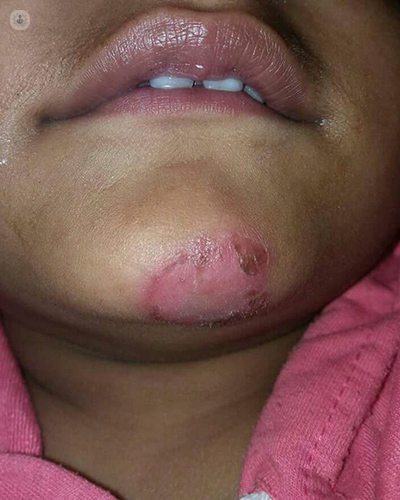

What is impetigo?
Impetigo is a highly contagious infection of the skin which is usually caused by staphylococcal or streptococcal bacteria. It enters through a crack in the skin such as a wound, scratch, cut or bite of an insect. It is not generally serious and generally clears within a few days to a few weeks with the right treatment.
It can be spread through skin to skin contact or (although less frequently) through contact from bedsheets, towels, and clothing. As it can spread quickly, it is one of the most common skin infections in children in the UK.

What are the symptoms of impetigo?
The main symptom of impetigo is reddish rashes similar to pimples usually on the face, arms and legs. These sores are filled with pus and they break open and form yellow crusts on the skin. Swollen lymph nodes may also occur, though fever is unusual.
Impetigo can appear anywhere on the body, but it is more common on areas of the skin which are exposed, such as the face and hands.
What are the causes of impetigo?
The cause of impetigo is staphylococcal bacteria. This bacteria more commonly infects cuts, wounds, grazes, cold sores, or eczema, but it can infect ‘normal’ skin as well. Impetigo may also occur after having a cold or virus. It is more common in warm, humid weather.
Treatment of impetigo
The first step of treatment is to remove the crusting on the skin gently, using antibacterial soap or wash. After this, an antibiotic cream can be applied onto the patches of impetigo and in the general area around the patch, a few times a day until the infection clears. Your doctor will prescribe the ideal cream and recommend a cleaning routine. In some cases, oral antibiotics may be prescribed.
How can impetigo be prevented?
The spread of impetigo can be prevented through good hygiene habits, and avoiding contact with those who already have an impetigo infection. If you have impetigo, you can try to reduce the risk of it spreading to others by washing your hands after touching the sores, after applying cream, and daily changing sheets and towels.
